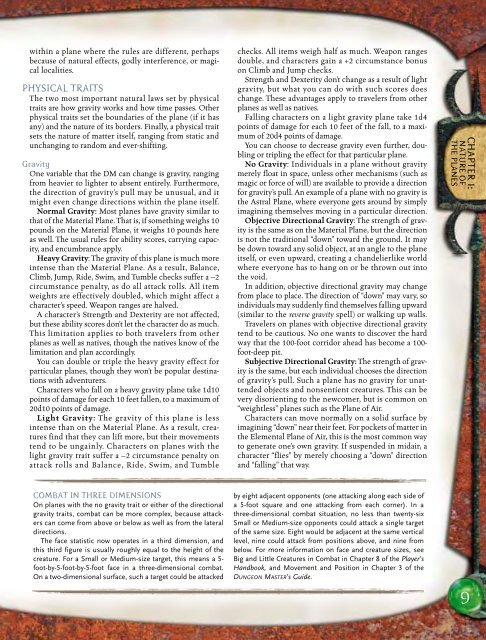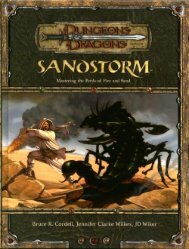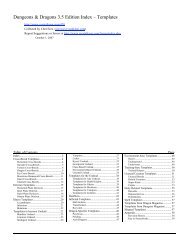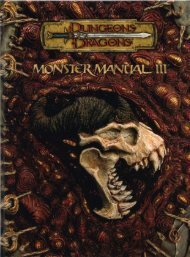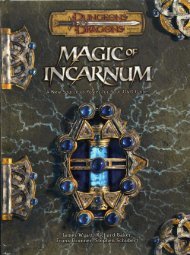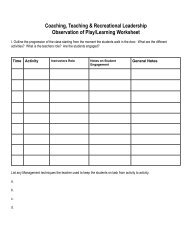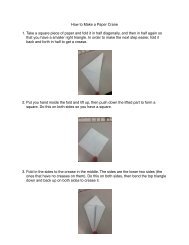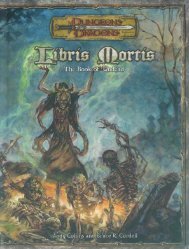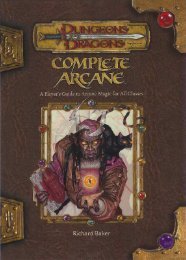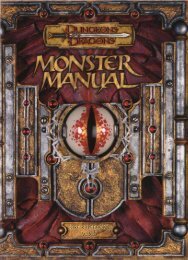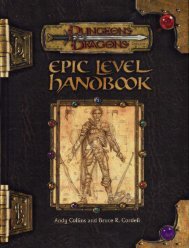Manual of the Planes
Manual of the Planes
Manual of the Planes
- No tags were found...
You also want an ePaper? Increase the reach of your titles
YUMPU automatically turns print PDFs into web optimized ePapers that Google loves.
within a plane where <strong>the</strong> rules are different, perhapsbecause <strong>of</strong> natural effects, godly interference, or magicallocalities.PHYSICAL TRAITSThe two most important natural laws set by physicaltraits are how gravity works and how time passes. O<strong>the</strong>rphysical traits set <strong>the</strong> boundaries <strong>of</strong> <strong>the</strong> plane (if it hasany) and <strong>the</strong> nature <strong>of</strong> its borders. Finally, a physical traitsets <strong>the</strong> nature <strong>of</strong> matter itself, ranging from static andunchanging to random and ever-shifting.GravityOne variable that <strong>the</strong> DM can change is gravity, rangingfrom heavier to lighter to absent entirely. Fur<strong>the</strong>rmore,<strong>the</strong> direction <strong>of</strong> gravity’s pull may be unusual, and itmight even change directions within <strong>the</strong> plane itself.Normal Gravity: Most planes have gravity similar tothat <strong>of</strong> <strong>the</strong> Material Plane. That is, if something weighs 10pounds on <strong>the</strong> Material Plane, it weighs 10 pounds hereas well. The usual rules for ability scores, carrying capacity,and encumbrance apply.Heavy Gravity: The gravity <strong>of</strong> this plane is much moreintense than <strong>the</strong> Material Plane. As a result, Balance,Climb, Jump, Ride, Swim, and Tumble checks suffer a –2circumstance penalty, as do all attack rolls. All itemweights are effectively doubled, which might affect acharacter’s speed. Weapon ranges are halved.A character’s Strength and Dexterity are not affected,but <strong>the</strong>se ability scores don’t let <strong>the</strong> character do as much.This limitation applies to both travelers from o<strong>the</strong>rplanes as well as natives, though <strong>the</strong> natives know <strong>of</strong> <strong>the</strong>limitation and plan accordingly.You can double or triple <strong>the</strong> heavy gravity effect forparticular planes, though <strong>the</strong>y won’t be popular destinationswith adventurers.Characters who fall on a heavy gravity plane take 1d10points <strong>of</strong> damage for each 10 feet fallen, to a maximum <strong>of</strong>20d10 points <strong>of</strong> damage.Light Gravity: The gravity <strong>of</strong> this plane is lessintense than on <strong>the</strong> Material Plane. As a result, creaturesfind that <strong>the</strong>y can lift more, but <strong>the</strong>ir movementstend to be ungainly. Characters on planes with <strong>the</strong>light gravity trait suffer a –2 circumstance penalty onattack rolls and Balance, Ride, Swim, and Tumblechecks. All items weigh half as much. Weapon rangesdouble, and characters gain a +2 circumstance bonuson Climb and Jump checks.Strength and Dexterity don’t change as a result <strong>of</strong> lightgravity, but what you can do with such scores doeschange. These advantages apply to travelers from o<strong>the</strong>rplanes as well as natives.Falling characters on a light gravity plane take 1d4points <strong>of</strong> damage for each 10 feet <strong>of</strong> <strong>the</strong> fall, to a maximum<strong>of</strong> 20d4 points <strong>of</strong> damage.You can choose to decrease gravity even fur<strong>the</strong>r, doublingor tripling <strong>the</strong> effect for that particular plane.No Gravity: Individuals in a plane without gravitymerely float in space, unless o<strong>the</strong>r mechanisms (such asmagic or force <strong>of</strong> will) are available to provide a directionfor gravity’s pull. An example <strong>of</strong> a plane with no gravity is<strong>the</strong> Astral Plane, where everyone gets around by simplyimagining <strong>the</strong>mselves moving in a particular direction.Objective Directional Gravity: The strength <strong>of</strong> gravityis <strong>the</strong> same as on <strong>the</strong> Material Plane, but <strong>the</strong> directionis not <strong>the</strong> traditional “down” toward <strong>the</strong> ground. It maybe down toward any solid object, at an angle to <strong>the</strong> planeitself, or even upward, creating a chandelierlike worldwhere everyone has to hang on or be thrown out into<strong>the</strong> void.In addition, objective directional gravity may changefrom place to place. The direction <strong>of</strong> “down” may vary, soindividuals may suddenly find <strong>the</strong>mselves falling upward(similar to <strong>the</strong> reverse gravity spell) or walking up walls.Travelers on planes with objective directional gravitytend to be cautious. No one wants to discover <strong>the</strong> hardway that <strong>the</strong> 100-foot corridor ahead has become a 100-foot-deep pit.Subjective Directional Gravity: The strength <strong>of</strong> gravityis <strong>the</strong> same, but each individual chooses <strong>the</strong> direction<strong>of</strong> gravity’s pull. Such a plane has no gravity for unattendedobjects and nonsentient creatures. This can bevery disorienting to <strong>the</strong> newcomer, but is common on“weightless” planes such as <strong>the</strong> Plane <strong>of</strong> Air.Characters can move normally on a solid surface byimagining “down” near <strong>the</strong>ir feet. For pockets <strong>of</strong> matter in<strong>the</strong> Elemental Plane <strong>of</strong> Air, this is <strong>the</strong> most common wayto generate one’s own gravity. If suspended in midair, acharacter “flies” by merely choosing a “down” directionand “falling” that way.pqqqqrsCOMBAT IN THREE DIMENSIONSOn planes with <strong>the</strong> no gravity trait or ei<strong>the</strong>r <strong>of</strong> <strong>the</strong> directionalgravity traits, combat can be more complex, because attackerscan come from above or below as well as from <strong>the</strong> lateraldirections.The face statistic now operates in a third dimension, andthis third figure is usually roughly equal to <strong>the</strong> height <strong>of</strong> <strong>the</strong>creature. For a Small or Medium-size target, this means a 5-foot-by-5-foot-by-5-foot face in a three-dimensional combat.On a two-dimensional surface, such a target could be attackedby eight adjacent opponents (one attacking along each side <strong>of</strong>a 5-foot square and one attacking from each corner). In athree-dimensional combat situation, no less than twenty-sixSmall or Medium-size opponents could attack a single target<strong>of</strong> <strong>the</strong> same size. Eight would be adjacent at <strong>the</strong> same verticallevel, nine could attack from positions above, and nine frombelow. For more information on face and creature sizes, seeBig and Little Creatures in Combat in Chapter 8 <strong>of</strong> <strong>the</strong> Player’sHandbook, and Movement and Position in Chapter 3 <strong>of</strong> <strong>the</strong>DUNGEON MASTER’s Guide.pqqqqrsCHAPTER 1:NATURE OFTHE PLANES9


